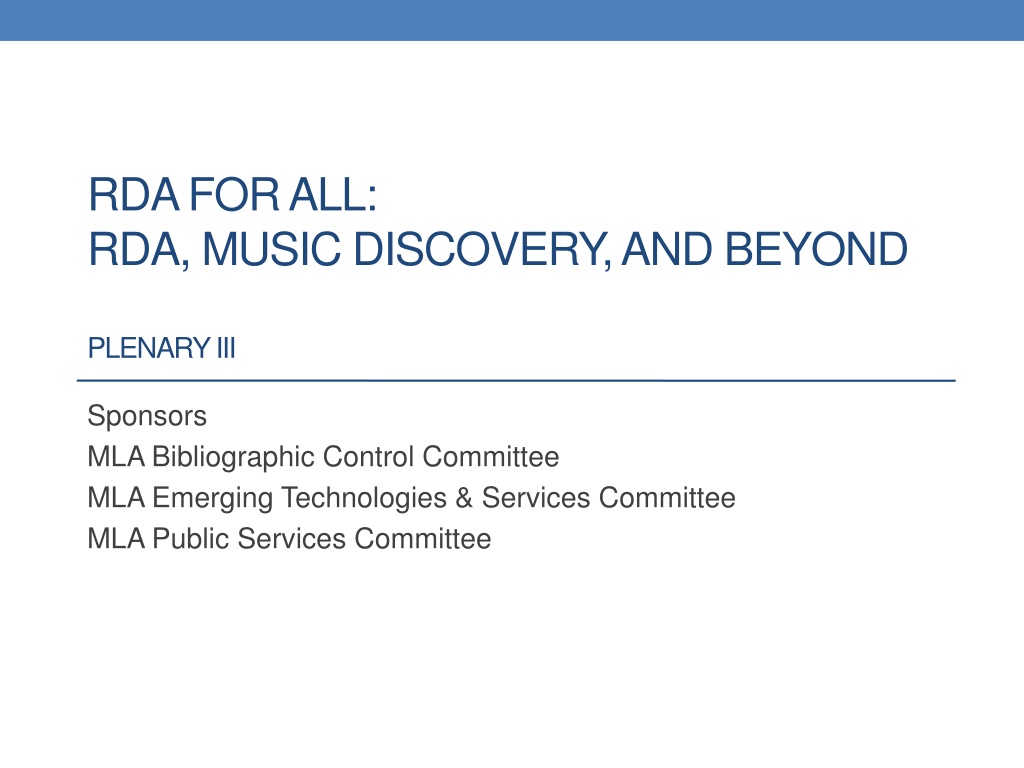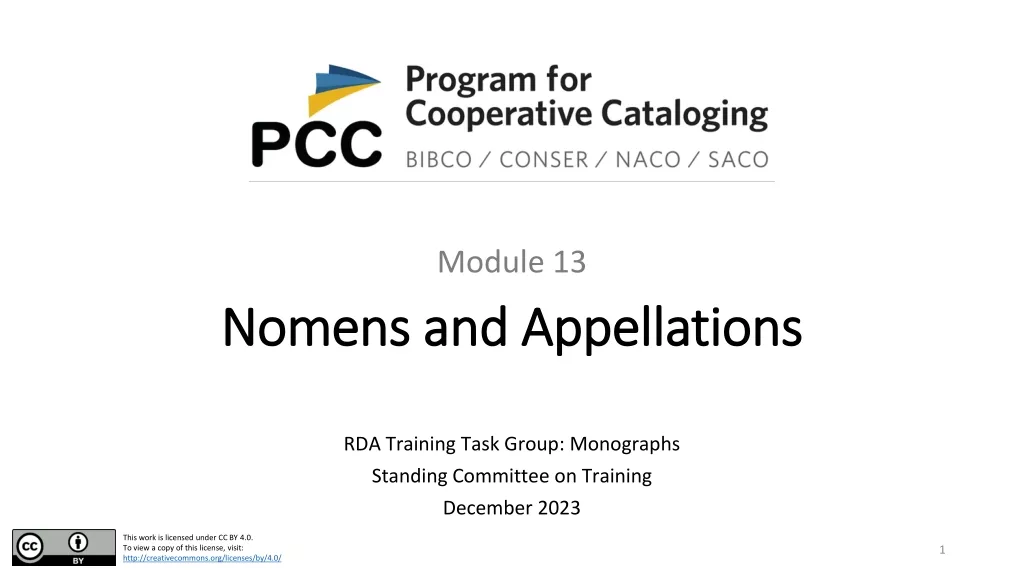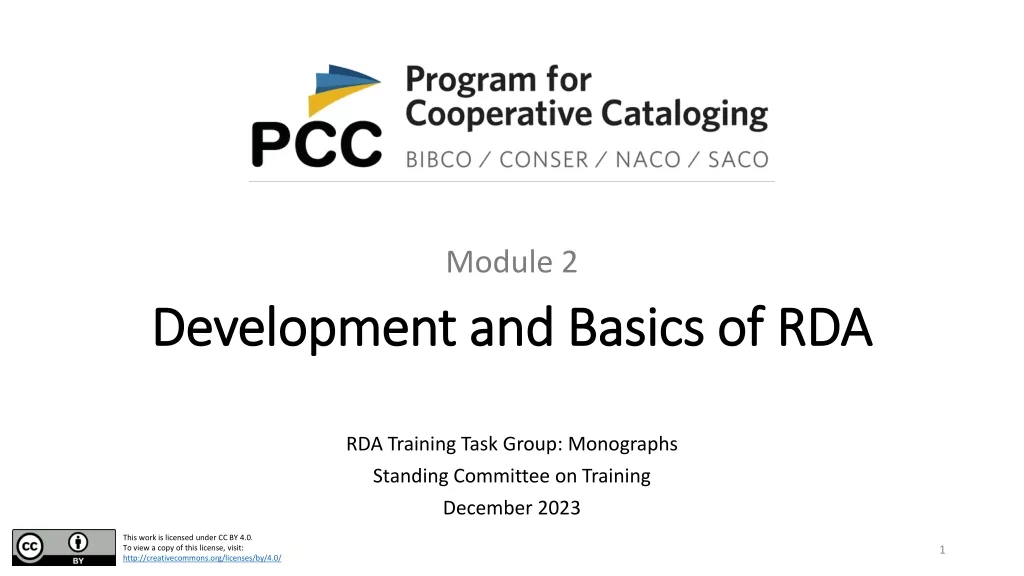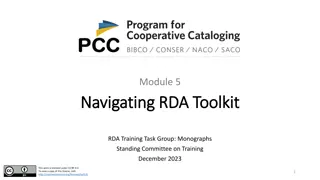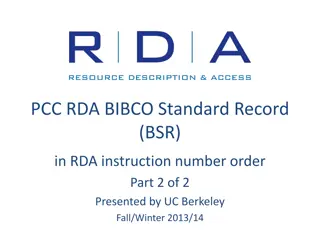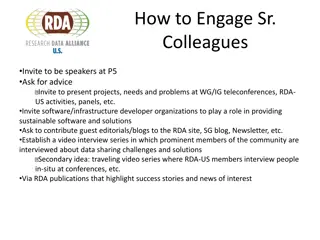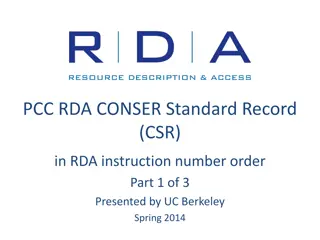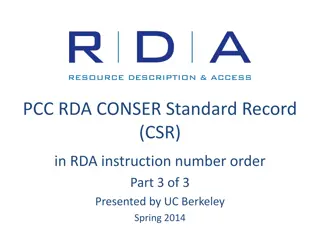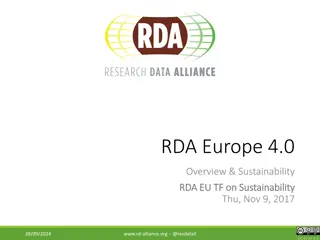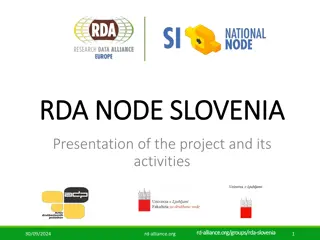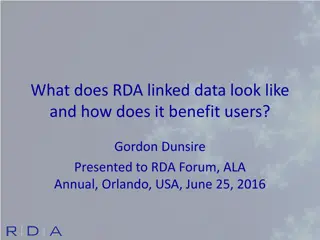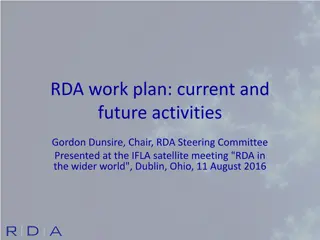RDA Impact and Evolution in Library Resources
Realizing the need for revision, librarians evolved from AACR2 to RDA for better bibliographic control. Conferences, drafts, and reviews shaped RDA's development aligning with international standards.
Download Presentation

Please find below an Image/Link to download the presentation.
The content on the website is provided AS IS for your information and personal use only. It may not be sold, licensed, or shared on other websites without obtaining consent from the author.If you encounter any issues during the download, it is possible that the publisher has removed the file from their server.
You are allowed to download the files provided on this website for personal or commercial use, subject to the condition that they are used lawfully. All files are the property of their respective owners.
The content on the website is provided AS IS for your information and personal use only. It may not be sold, licensed, or shared on other websites without obtaining consent from the author.
E N D
Presentation Transcript
RDA FOR ALL: RDA, MUSIC DISCOVERY, AND BEYOND PLENARY III Sponsors MLA Bibliographic Control Committee MLA Emerging Technologies & Services Committee MLA Public Services Committee
RDA for All Overview of RDA Impact of RDA on Public Services Impact of RDA on Technical Services RDA and Music Discovery Developments Beyond RDA
RDA for All Slides will be available on the BCC website: http://bcc.musiclibraryassoc.org/bcc.html
RDA for All Speakers Kathy Glennan Stephanie Bonjack University of Southern California Nara Newcomer University of Missouri-Kansas City Stephen Henry University of Maryland University of Maryland
RDA OVERVIEW Kathy Glennan University of Maryland March 2, 2013
The Evolution of RDA Problem: In the late 1980s, librarians began to realize that AACR2 needed revision to address various problems, including: Changing nature of library resources Separating content from carrier Clarifying bibliographic relationships Coming to a common understanding about what constitutes a work Resolving issues around seriality
The Evolution of RDA Solution #1: Conferences held, focusing on special issues 1989 Airlie House Forum on Multiple Versions 1997 International Conference on the Principles and Future Development of AACR Solution #2: Changes made to AACR2 AACR2r published in 2002; updated in 2004 Solution #3: Draft of AACR3 2004, Draft of Part 1 released for review Reviewers felt this needed a new focus and a new name, so
RDA was born! Drafts available for open review, 2005-2009 Various constituencies conducted reviews and wrote proposals for change MLA contributed comments and proposals through the American Library Association Development took longer than anticipated Incorporated structure, concepts and terminology from two IFLA documents, Functional Requirements for Bibliographic Records (1998) and Functional Requirements for Authority Data (2009) Aligned with IFLA s Statement of International Cataloguing Principles (2009)
RDAs Scope Includes instructions for recording Descriptive elements relating to: Works, Expressions, Manifestations, Items Attributes associated with creators and contributors: Persons, Families and Corporate Bodies Relationships among and between the above entities, such as: Person to work Composer; Arranger of music; Performer; Conductor Work to work Musical variations based on; Cadenza composed for Will eventually include instructions for concepts, objects, events and places
RDA Goals Focus on user tasks: Find, Identify, Select, Obtain Simplify, clarify and update the rules Get rid of unnecessary library jargon, like Latin abbreviations Remove ambiguous & inconsistent terminology Eliminate redundant rules Emphasis on the rules as a content standard Separate recording of data from display of data Create a flexible and extensible framework Compatible with multiple data storage and communication models, such as MARC21 and Dublin Core and potentially future models like LC s Bibliographic Framework Initiative Maintain backwards compatibility with AACR2 records
RDA Controversies Too much change vs. not enough change Cost Online product requires annual subscription; unwieldy in print Catalogers need retraining Elimination of General Material Designation Used in AACR2 to identify broad types of resources Example: Symphony no. 5 [sound recording] Replaced by separate elements for content, media and carrier types, but the textual terms aren t very user friendly performed music audio audio disc Full benefit only realized once MARC is replaced Most local systems only doing bare bones implementation
RDA Benefits Registered vocabularies: http://rdvocab.info/ Designed to function in different implementation scenarios Flat file database structure (no links) Linked bibliographic and authority records Relational / object-oriented database structure Linked data Instructions not tied to physical format of resources Can accommodate metadata from multiple sources (e.g., ONIX data)
RDA Milestones Published Summer 2010 RDA Toolkit (online product); also in print U.S. National Libraries Test, Oct.-Dec. 2010 National libraries and test partners, included group from MLA/OLAC Bibliographic and Authority records created in live environment Participants feedback led to additional recommendations for change MARC21 updated: 2008-present National libraries implementation date: March 31, 2013 All authority record creation (affects all NACO participants) Most bibliographic record creation
IMPACT OF RDA ON TECHNICAL SERVICES Kathy Glennan University of Maryland March 2, 2013
Training Issues Identify affected Technical Services staff Original catalogers Copy catalogers Acquisitions specialists Determine what kind of training is needed for each Provide the appropriate level of training for the work being done Create in-house training, or use presentations, webinars, etc. developed by others Determine when and how to train original catalogers Opportunity for ground-up cataloging training Collective review of records before submission?
Training Issues Be aware of national policies and guidelines LC-PCC Policy Statements BIBCO Standard Record Metadata Application Profile Provider-Neutral E-Resource Guidelines OCLC RDA Policy Statement Create local policies When to use RDA records What changes are acceptable? Can you derive a new record from an RDA record, even if you re not yet trained in RDA?
Training Resources LC/PCC online training available at Catalogers Learning Workshop website: http://www.loc.gov/catworkshop/ LC-PCC Policy Statements incorporated into RDA Toolkit, linked to relevant instructions PCC guidelines: http://www.loc.gov/aba/pcc/ ALCTS webinars: http://www.ala.org/alcts/confevents/upcoming/webinar/cat Sample records and workflows available in RDA Toolkit Music cataloging presentations on BCC website: http://bcc.musiclibraryassoc.org/bcc.html MLA Best Practices out for review now!
Challenges for Catalogers Terminology changes Audio disc not Sound disc and Cello not Violoncello Almost no abbreviations But retained for duration, vocal parts (SATB), and thematic indexes New MARC fields and subfields to learn and use And to validate, index, and display in the local system
Challenges for Catalogers More decisions left to catalogers judgment Must keep user tasks in mind (Find, Identify, Select, Obtain) May need to accept less consistency among bibliographic records Capitalization practice Spelling of color vs. colour Updates to local cataloging policies needed RDA is constantly changing Updates to online RDA Toolkit every two months
Big or Incremental Change? Authority records All NACO participants must be retrained Set date for change-over no choice (3/31/13) Automated changes rolling out to authority file to make records RDA compliant Records that cannot be corrected through this process must be updated manually as encountered New data elements to learn and encode as appropriate Major documentation updates, best practice changes, etc. Opportunity to review local authority control practices and the staff involved
Big or Incremental Change? Bibliographic records Depends on local implementation decisions No set date for implementation at this time If converting all cataloging records to RDA as encountered BIG CHANGE If working with existing cataloging records without changing the cataloging code more of an INCREMENTAL CHANGE Use RDA for original cataloging and substantial upgrades to copy? Need to start developing familiarity and comfort with RDA instructions Must put training to use on a regular basis, or retraining will be necessary
